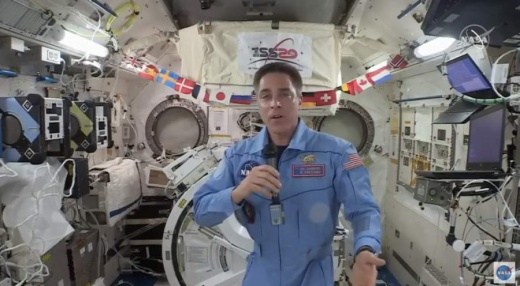NASA astronaut and current space station commander Christopher Cassidy answered educators’ questions from 250 miles above the Earth during a livestream event May 6.
Pre-recorded questions for Cassidy came from Space Center Houston’s international network of educators and the Space Exploration Educator Crew. Space Center Houston is the official visitor center of NASA’s Johnson Space Center, where astronauts are trained to further the agency’s space exploration goals.
Astronauts have continuously lived and worked on the space station for nearly two decades, testing technologies, performing experiments and developing the skills needed to explore farther from Earth, according to a Space Center Houston news release. NASA’s Mission Control Center in Houston communicates 24 hours a day with the astronauts living in space on the orbiting laboratory through the Space Network’s Tracking and Data Relay Satellites.
Space Center Houston aims to link educators and students directly to astronauts aboard the space station and provide authentic experiences designed to enhance student learning, performance and interest in STEM, per the release. Videos and lesson plans highlighting research on the International Space Station are available at www.nasa.gov/stemonstation. The live event was hosted in honor of Teacher Appreciation Week, which takes place May 4-8.
Cassidy answered various questions during the half-hour broadcast and gave insights on coronavirus-related matters. Here are three takeaways from Cassidy about how the world is responding to coronavirus.
No, you cannot see the effects of coronavirus from outer space
Although large gatherings of people have been virtually eliminated across the world in light of the pandemic, Cassidy said nothing in Earth’s atmosphere or cloud formations has indicated major changes to the physical landscape.
“We’ve been asked a few times, and I really have been trying with some diligence to see if there’s anything perceivable that I can notice with my eye,” Cassidy said in response to the question. “You don’t see that quite so much these days.”
He added, however, that he sees less airplane contrails—the line-shaped clouds produced by aircraft engine exhaust that form behind planes—in the skies from his vantage point aboard the International Space Station.
“It seems to me that airplane activity is less,” he said.
Students, educators need to strike a healthy balance, practice teamwork amid coronavirus
Throughout the broadcast, Cassidy answered questions about the problem-solving and crisis-management skills he learned through his work with NASA and his time as a U.S. Navy SEAL. When questions surfaced about how to cope with challenges like distance learning, he said that it is essential to establish boundaries.“I will tell you that it’s tough to find the balance between ... being there when you’re needed and not overstepping your bounds,” Cassidy said.
A Texas-based teacher asked Cassidy about his “most successful failure.” He described a space walk that failed logistically due to unforeseen circumstances and said that the long-term impacts of that failed space walk included new improvements to operational safety. Cassidy and the rest of the crew “could laugh about it once the helmets came off,” he said, because ultimately their teamwork still yielded positive results.
He likened this approach to how students and educators can best adapt amid school closures and the challenges of remote instruction: Work together and do not discount the importance of team-building skills.
“You’ve got to know when to be a leader and when to be a follower, and it’ll all pull together,” he said. “The technical things we can train ... it’s those soft skills that are of critical importance.”
NASA is active in the fight against the coronavirus
Cassidy was asked during the broadcast about NASA’s contributions to coronavirus mitigation efforts but could not recall any specific projects.“In certain times we can access the Internet up here. ... So you gave me a good homework assignment,” he told the teacher who asked the question.
According to NASA’s press desk, the agency first took action last month. NASA launched a call for ideas April 1 on its internal crowdsourcing platform NASA@WORK for how the agency can leverage its expertise and capabilities to assist with the global crisis. In two weeks the agency received 250 ideas, with more than 500 comments submitted and more than 4,500 votes cast, according to a news release.
Engineers at NASA’s jet propulsion laboratory in California designed a new high-pressure ventilator tailored specifically to treat the coronavirus patients called VITAL (Ventilator Intervention Technology Accessible Locally), which passed a critical test April 21 at the Icahn School of Medicine at Mount Sinai in New York—an epicenter of the virus in the United States. Other efforts include a positive pressure oxygen helmet—which functions similar to a CPAP machine and used to treat patients exhibiting minor symptoms, minimizing the need for ventilators with those patients—and a new surface decontamination system.
VITAL is under review for an emergency use authorization by the Food and Drug Administration, as is the Aerospace Valley Positive Pressure Helmet, per the release.
"NASA's strength has always been our ability and passion—collective and individual—for solving problems," NASA Administrator Jim Bridenstine said in the release. "All the work being done shows how NASA is uniquely equipped to aid in the federal response to coronavirus by leveraging the ingenuity of our workforce, mobilizing investments made in the U.S. space agency to combat this disease, and working with public and private partnerships to maximize results."





